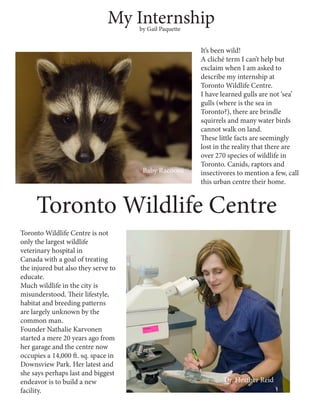
Paquette_InternshipReflection
- 1. Toronto Wildlife Centre My Internship It’s been wild! A cliché term I can’t help but exclaim when I am asked to describe my internship at Toronto Wildlife Centre. I have learned gulls are not ‘sea’ gulls (where is the sea in Toronto?), there are brindle squirrels and many water birds cannot walk on land. These little facts are seemingly lost in the reality that there are over 270 species of wildlife in Toronto. Canids, raptors and insectivores to mention a few, call this urban centre their home. Toronto Wildlife Centre is not only the largest wildlife veterinary hospital in Canada with a goal of treating the injured but also they serve to educate. Much wildlife in the city is misunderstood. Their lifestyle, habitat and breeding patterns are largely unknown by the common man. Founder Nathalie Karvonen started a mere 20 years ago from her garage and the centre now occupies a 14,000 ft. sq. space in Downsview Park. Her latest and she says perhaps last and biggest endeavor is to build a new facility. Baby Racoons Dr. Heather Reid by Gail Paquette
- 2. This is mainly because their lease is not being renewed due to the park’s massive renovation and rebranding plan. http://www.downsviewpark. ca/content/about-downs- view-park-0 It is inherently apparent that this is a blessing in disguise. Their need is great and so should their facility be. Not only is the medical staff devoted but also Nathalie has surrounded herself with a dedicated and innovative fund raising team, loyal office administrators, knowledgeable hotline staff and a fearless rescue team. Operation to remove bullet Robin to be released
- 3. Migratory birds are the most common patients in springtime, as are orphaned babies. The birds most frequently fly into buildings that perhaps didn’t exist on their flight path last year (not surprising) and babies are admitted most often because something has happened to the parents to prevent them from caring for them or they are injured. The volunteer base at the centre is massive, the donor base notable, internship programs impressive and facilities innovative. Toronto Wildlife Centre serves to promote the co-existence of people and wildlife. It is something I know too little about. I have that in common with many Torontonians. Rescued baby squirrel Release of the Common Flicker
- 4. I found myself being amazingly educated on some things perhaps I once took for granted or frankly felt stupid, that as a Canadian, I did not know more about our com- mon wildlife. More importantly was my realization that wildlife exists and thrives in Toronto, thus many urban centres in Canada. That is why Toronto Wildlife Centre exists, an amazing team from whom we can learn from; seek advice, help and guidance. As I write this, I think of the times I have come across injured animals, knowing not what to do but let ‘nature take it’s course,’ when in fact, it was not nature but humans that unintentionally caused the injury. I believe we all have. Baby Snapping Turtle Garter Snake
- 5. I have great respect for Toronto Wildlife Centre as they not only face the ongoing patient admissions but also continue their fastidious endeavors of creating a new home. With my background in photography and photojournalism, my PR internship was mainly taking photographs! Woooohoooo! I was ecstatic. This was certainly a way I could help. Let me just say, being a wild- life photographer (inside a controlled environment or not) takes patience and thousands of shots. It means no flash, low lighting and precise focus. A lot of times things happen the millisecond you are not ready. My most fascinating shoot was an operation to remove a pellet bullet from a red tailed hawk. As the team worked intricately to remove the bullet, noting blood pressure and heart rate, Dr. Heather Reid remarked to me, “It’s never as easy as they make it out to be in CSI.” The outcome was a success and I was there to feel the importance. Sometimes the centre cannot fix a poor injured animal but they can give support, guidance, instruction and reassurance. The hotline staff says it is often the human that is in worse shape then the wildlife, during the rescue call. Operation Red-tailed Hawk
- 6. Some of the more than 5000 pics I took will be used in their efforts to raise the money to build their new facility and I couldn’t be happier. As a registered charity, supported primarily by donations, contributions can be made on many levels. Cages Rescue equipment Food
- 7. Their wish list is extensive. http://www.torontowildlifecentre.com/wishlist Ways to donate is all-inclusive. http://www.torontowildlifecentre.com/donate-or-volunteer Trimming a hawk’s beak Rescued beaver Tube feeding a swan Donations of all kinds ensure they continue to succeed in in their mission of, “Building a healthy community for people and wildlife.” I know I sleep better at night knowing we can exist together.
